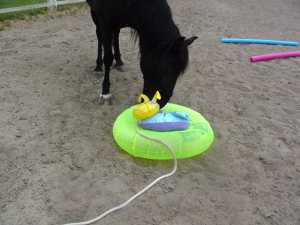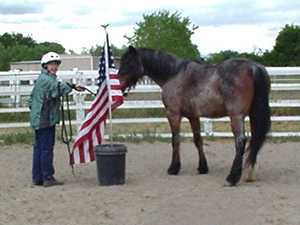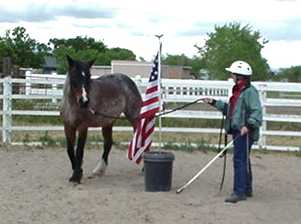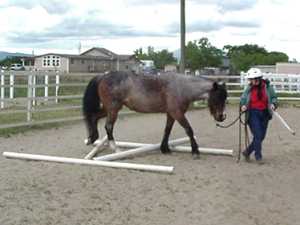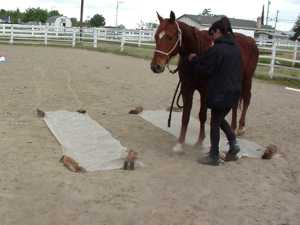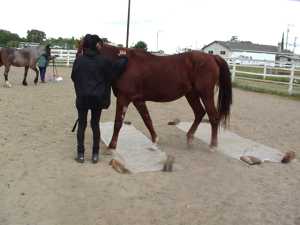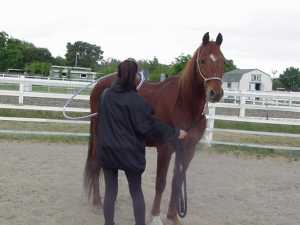Bomb Proofing:
|
Velvet inspecting the "toys"
| |||
|
Horses are creatures of behavioral habits. They memorize patterns that are either comfortable or uncomfortable to them. Research shows that they actually develop neuropathways based on their experiences, linking stimulus to survival (flight or fight) behaviors or curiosity / acceptance, depending on how that stimulus is perceived. The human environment is filled with a variety of ever changing stimuli. Although desensitizing can take place any time, it makes sense to get horses comfortable around a variety of different objects and sensations early on in their training. Bomb proofing is useful for any horse ... from newborn foalsNote 1 to twenty-something adults. If the challenges are mentally stimulating, are presented in a way that is more interesting than frightening, and the human handlers maintain positive attitudes, bomb proofing can help virtually any horse. The idea is to get the horse to think (use the left side of his brain) and look to his handler for guidance in solving puzzles. In this feature the LRTC Wild Horse Mentors set up a bomb proofing course for fun and fortunately someone had a camera. We'll follow some of the horses through the exercises. (For background information on building and using obstacles, please visit Building Yourself a Horse Course.) This photo collage starts out by illustrating horses interacting with various items in the arena, and is followed by accounts of more advanced and formal bomb proofing activities held in Nevada along with explanations as to the various elements and how best to use them. The activities progress from simple to complex. |
| "LEFT BRAIN" ACTION |
Dahlia and Becky
| Dahlia is an older mare rescued some years ago from an abusive environment. She has come a long way and is pretty solid, but she still can benefit from being asked to focus on her handler amidst a variety of stimuli. | |
Approaching the scary flag
|
Longeing around the scary flag
|
Working through the labyrinth
|
Over more complicated ground poles
|
Diamond and Andrea
| Diamond was rescued from the 2003 Southern California firestorms. He's pretty steady considering all he has been through but he still can stand to improve his focus. | |
Walking through the spinning flowers
|
Entering the plastic crossings
|
Walking over the plastic
|
Rubbing with a ring & Lots of positive reinforcement
|
|
You may notice that we have two strips of plastic to navigate. We neither want the horse to fixate on a single piece of plastic nor consider jumping it to avoid it. Using two pieces of plastic requires the horse to focus and also deal with multiple objects.
Note 1: We used to recommend bomb proofing for horses yearling age and older. After visiting Allen Pogue's web feature, Enhanced Foal Training we realized we needed to broaden our thinking. Although their attention spans are shorter and the motivational factors may be different, Allen clearly shows how foals can accept new stimuli exceptionally well! Continue to Part TwoPress Back to return to the page which brought you hereGo to Clicker Case Study SectionReturn to KBR Training SectionReturn to KBR World of Wild Horses & BurrosGo to other Wild Horse LinksGo To
| |

